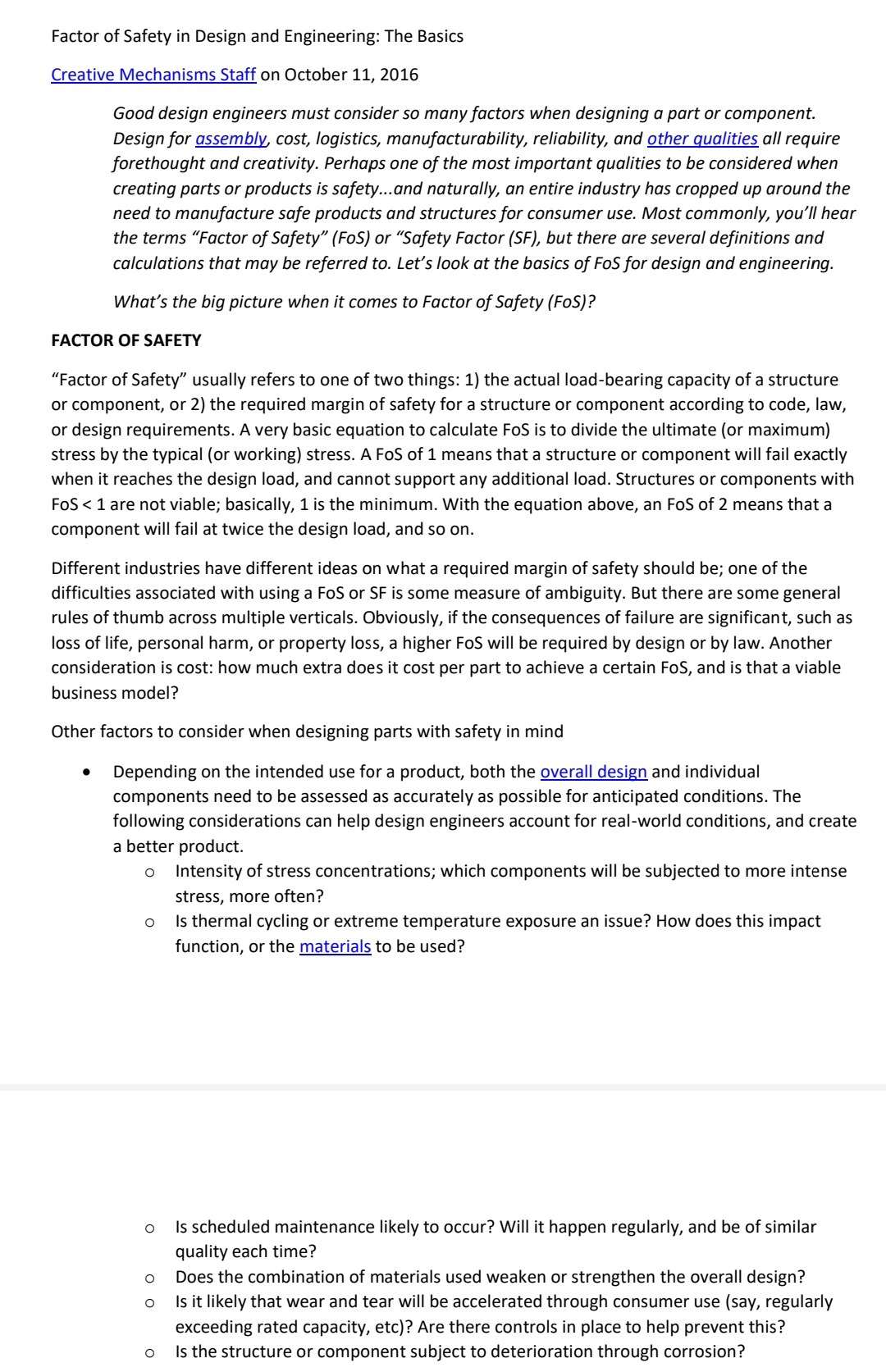Explain why Factor of Safety are important in Engineering field of study, especially in
Explain why Factor of Safety are important in Engineering field of study, especially in
Principles of Heat Transfer (Activate Learning with these NEW titles from Engineering!)
8th Edition
ISBN:9781305387102
Author:Kreith, Frank; Manglik, Raj M.
Publisher:Kreith, Frank; Manglik, Raj M.
Chapter1: Basic Modes Of Heat Transfer
Section: Chapter Questions
Problem 1.3DP
Related questions
Question
Explain why Factor of Safety are important in Engineering field of study, especially in engineering design. Thank you:!

Transcribed Image Text:Factor of Safety in Design and Engineering: The Basics
Creative Mechanisms Staff on October 11, 2016
Good design engineers must consider so many factors when designing a part or component.
Design for assembly, cost, logistics, manufacturability, reliability, and other qualities all require
forethought and creativity. Perhaps one of the most important qualities to be considered when
creating parts or products is safety...and naturally, an entire industry has cropped up around the
need to manufacture safe products and structures for consumer use. Most commonly, you'll hear
the terms "Factor of Safety" (FoS) or "Safety Factor (SF), but there are several definitions and
calculations that may be referred to. Let's look at the basics of FoS for design and engineering.
What's the big picture when it comes to Factor of Safety (FOS)?
FACTOR OF SAFETY
"Factor of Safety" usually refers to one of two things: 1) the actual load-bearing capacity of a structure
or component, or 2) the required margin of safety for a structure or component according to code, law,
or design requirements. A very basic equation to calculate FoS is to divide the ultimate (or maximum)
stress by the typical (or working) stress. A FoS of 1 means that a structure or component will fail exactly
when it reaches the design load, and cannot support any additional load. Structures or components with
FoS < 1 are not viable; basically, 1 is the minimum. With the equation above, an FoS of 2 means that a
component will fail at twice the design load, and so on.
Different industries have different ideas on what a required margin of safety should be; one of the
difficulties associated with using a FoS or SF is some measure of ambiguity. But there are some general
rules of thumb across multiple verticals. Obviously, if the consequences of failure are significant, such as
loss of life, personal harm, or property loss, a higher FoS will be required by design or by law. Another
consideration is cost: how much extra does it cost per part to achieve a certain FoS, and is that a viable
business model?
Other factors to consider when designing parts with safety in mind
Depending on the intended use for a product, both the overall design and individual
components need to be assessed as accurately as possible for anticipated conditions. The
following considerations can help design engineers account for real-world conditions, and create
a better product.
O Intensity of stress concentrations; which components will be subjected to more intense
stress, more often?
O
O
Is thermal cycling or extreme temperature exposure an issue? How does this impact
function, or the materials to be used?
O
Is scheduled maintenance likely to occur? Will it happen regularly, and be of similar
quality each time?
O
O Does the combination of materials used weaken or strengthen the overall design?
Is it likely that wear and tear will be accelerated through consumer use (say, regularly
exceeding rated capacity, etc)? Are there controls in place to help prevent this?
Is the structure or component subject to deterioration through corrosion?
Expert Solution
This question has been solved!
Explore an expertly crafted, step-by-step solution for a thorough understanding of key concepts.
Step by step
Solved in 3 steps with 2 images

Knowledge Booster
Learn more about
Need a deep-dive on the concept behind this application? Look no further. Learn more about this topic, mechanical-engineering and related others by exploring similar questions and additional content below.Recommended textbooks for you

Principles of Heat Transfer (Activate Learning wi…
Mechanical Engineering
ISBN:
9781305387102
Author:
Kreith, Frank; Manglik, Raj M.
Publisher:
Cengage Learning

Principles of Heat Transfer (Activate Learning wi…
Mechanical Engineering
ISBN:
9781305387102
Author:
Kreith, Frank; Manglik, Raj M.
Publisher:
Cengage Learning